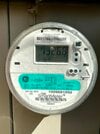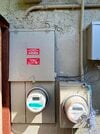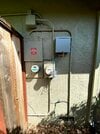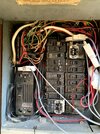Welcome to Tesla Motors Club
Discuss Tesla's Model S, Model 3, Model X, Model Y, Cybertruck, Roadster and More.
Register
Install the app
How to install the app on iOS
You can install our site as a web app on your iOS device by utilizing the Add to Home Screen feature in Safari. Please see this thread for more details on this.
Note: This feature may not be available in some browsers.
-
Want to remove ads? Register an account and login to see fewer ads, and become a Supporting Member to remove almost all ads.
You are using an out of date browser. It may not display this or other websites correctly.
You should upgrade or use an alternative browser.
You should upgrade or use an alternative browser.
Existing SunRun 2.8kWh system, want to add more from Tesla and add Powerwalls
- Thread starter dabreutx
- Start date
jhn_
Member
Hopefully not going off-topic... but even if you have a mortgage at single digit interest rates and have the money to pay it off, investing that money wisely at double digit percentage point gains instead is a better financial play.I am always amazed on folks who take 30 years to pay off a home loan. I paid mine off really early and the amount of interest I saved was amazing.
Vines
Active Member
Lots of good discussion here.
First step in my opinion is to understand what the existing service can do. Pleas post a picture of the panel, and the white (or yellowed) sticker on the inside of the lid.
While its easy to just say to upgrade to 200 or 400A, likely that's a 20-40k upgrade if you have an underground feed. We have installed plenty of systems on a 125A service. However a larger service may be an upgrade and valuable for other reasons.
As far as who will do this, I agree that a smaller shop will be more flexible, but you will pay more. This may be partially offset if you can still get SGIP funds, but those funds are going very quick. I see about $10 million left available in the current step. The firm I work for doesn't install less than 3 Powerwall units because the large scale SGIP has money still in it, which makes the 3rd battery very cheap.
Also good to notice that the Tesla system is 2.6 times as large of an energy reserve as the Sunrun system.
First step in my opinion is to understand what the existing service can do. Pleas post a picture of the panel, and the white (or yellowed) sticker on the inside of the lid.
While its easy to just say to upgrade to 200 or 400A, likely that's a 20-40k upgrade if you have an underground feed. We have installed plenty of systems on a 125A service. However a larger service may be an upgrade and valuable for other reasons.
As far as who will do this, I agree that a smaller shop will be more flexible, but you will pay more. This may be partially offset if you can still get SGIP funds, but those funds are going very quick. I see about $10 million left available in the current step. The firm I work for doesn't install less than 3 Powerwall units because the large scale SGIP has money still in it, which makes the 3rd battery very cheap.
Also good to notice that the Tesla system is 2.6 times as large of an energy reserve as the Sunrun system.
What option do we have?I’m always surprised how crap-tastic PG&E is, but people will still put up with their BS...
Thanks @Vines. Here are photos of the existing service. Additionally we have a 60A sub-panel in the garage that feeds the kitchen and the master bathroom. But that's coming off the main service panel.Lots of good discussion here.
First step in my opinion is to understand what the existing service can do. Pleas post a picture of the panel, and the white (or yellowed) sticker on the inside of the lid.
While its easy to just say to upgrade to 200 or 400A, likely that's a 20-40k upgrade if you have an underground feed. We have installed plenty of systems on a 125A service. However a larger service may be an upgrade and valuable for other reasons.
As far as who will do this, I agree that a smaller shop will be more flexible, but you will pay more. This may be partially offset if you can still get SGIP funds, but those funds are going very quick. I see about $10 million left available in the current step. The firm I work for doesn't install less than 3 Powerwall units because the large scale SGIP has money still in it, which makes the 3rd battery very cheap.
Also good to notice that the Tesla system is 2.6 times as large of an energy reserve as the Sunrun system.
Thanks for your advice here. Really appreciate it.
Attachments
What option do we have?
I, for one, like to complain about PG&E non-stop because PG&E is a source of infinite BS.
But really, I feel like anyone with a home that can fit solar should be trying to max out their panels. And they should install at least 1 battery so they can be their own net-metering program and get closer to 1:1 true costs. PG&E continues to screw solar-only customers with the time of use (TOU) rates. I agree states with 1:1 true net metering probably don't need batteries, but this is PG&E we're talking about.
With PG&E's EV2-A rate plan, I estimate that a homeowner needs their solar to produce at least 150% annual consumption in order to "break even" at today's TOU rates assuming they do nothing to modify their daily household behavior and energy use. This is because a residential solar array would generate power at about $0.20 per kWh, but the same home's average usage would be about $0.30 per kWh assuming the household uses peak time energy consistent with the CAISO projections of residential peak time demand.
Also, consider PG&E has committed to making rates even worse going forward as they attempt to get residential solar customers (who do not have batteries) to "pay their fair share" of things in addition to the NBCs they charge per month. So that $0.20 will likely stay stagnant (or decrease) over time, while the $0.30 will go up at 5% or more per year as PG&E sticks it to rate payers who aren't on the CARE/FERA rate. Bottom line, the average homeowner who isn't low-income is better off banking their own power so they aren't beholden to the utilities gaming of time and rates.
Unfortunately, PG&E spends a lot of money trying to brainwash homeowners. They want you to believe that it's free to modify behavior to not use much energy from 4pm to 9pm (normal peak time). Therefore, the implication of this PG&E-favorable mindset is that buying a battery to help power a home from 4 to 9pm is wasting money. They want people to believe the alternative to a battery was "free behavior modification".
But you and I both know that if you cooked dinner at 6pm on an electric range and did your chores before bedtime, there's an implied benefit there. Unfortunately, the solar and battery companies do not know how to advertise this time-shifting benefit very well. Most PV+ESS companies just think of batteries as a form of resiliency to mitigate the impact of blackouts.
I'd go further to say Sunrun and many Bay Area installers don't even know how to install a ESS to do this time-shifting benefit very well (edit: except if @Vines is involved). So, the true value proposition of what a battery provides is tough for most people to swallow. I hope you can make a case to get at least one or two batteries for your home in the long run to get separation from PG&E's manipulation.
But there are people who don't think PG&E is all that bad and will mostly defend PG&E as an ok organization... and that really confuses me.
Last edited:
This is a bit above my pay grade, but I think that if the loads fit within a NEC load calc for 125A you might be able to feed the service straight into the Gateway 2 and use a new larger panel to manage the 120% rule to fit a lot more solar. I'm not sure if this would even require activating the PCS feature in the Gateway 2.
Yeah, I think this depends on whether nor not my experience with PG&E was a one-off, or if PG&E is really taking a hardline stance on the 120 percent rule.
Under solar-only installs, the 120 percent rule assumes the only thing exporting to the grid is the solar (haha so obvious). So if you have say 40A of solar on a 200A service main breaker with a 200A busbar... Then you could do the math:
200A busbar x 120% = 240A ... then from the 240A minus the 200A main service breaker and calculate a 40A solar works fine.
But, PG&E thinks ESS are grid-exporting even when paired with solar. So if you want for example 2 Tesla Powerwalls plus a 40A solar array (about 9.6 kWp AC), then PG&E will say the total exporting facility is like 80A since each Powerwall is about 20A, and you'd have 40A exporting from the solar.
I have 200A service coming into my house (which PG&E confirmed). And the plan was going to have a brand new main service panel with 225A busbar. Even with this, PG&E was trying to force me to de-rate my downstream loads so much that it made a whole home backup or partial home backup basically impossible. It was one of many ways PG&E tried to prevent me from getting PV+ESS.
Vines
Active Member
Got it, thanks for those pictures. Looking at your service, I have another question:Thanks @Vines. Here are photos of the existing service. Additionally we have a 60A sub-panel in the garage that feeds the kitchen and the master bathroom. But that's coming off the main service panel.
Thanks for your advice here. Really appreciate it.
What is going on with the second meter there? Is that an EV charger meter? If so does it have its own service drop from the transformer, or is it tapped off the service for the home?
Getting back to the issue at the core here, the 125A service panel you have can take a 125A breaker (THQL21125) So unless you are popping the main breaker or planning on adding more loads I would leave that panel alone. You can install a new service if you want that upgrade.
So if I was designing it, I'd recommend some PV to offset your projected usage, 3 Powerwalls and land all the generation inside the Gateway 2 internal subpanel. I'd install a new 200A or 125A "Essential Loads" subpanel with 125A main breaker within 5' of the existing service and relocate all the loads to be backed up into that.
As long as you aren't installing more than 125A of PV and 200A of total generation this is the approach I would take, and it does not require relying on PCS settings.
Thanks so much. That second meter says "SunRun" on it, no idea what it does or why it is there. I'd love to just keep the existing panel with a 125A breaker, or replace that panel with another 125A panel that is newer, in place, and not mess with PG&E if I can help it for obvious reasons. Love to know that we can do this without updating the main panel just to avoid the mess with PG&E. I will PM you - I think you are in the South Bay, and let's chat more specifics?Got it, thanks for those pictures. Looking at your service, I have another question:
What is going on with the second meter there? Is that an EV charger meter? If so does it have its own service drop from the transformer, or is it tapped off the service for the home?
Getting back to the issue at the core here, the 125A service panel you have can take a 125A breaker (THQL21125) So unless you are popping the main breaker or planning on adding more loads I would leave that panel alone. You can install a new service if you want that upgrade.
So if I was designing it, I'd recommend some PV to offset your projected usage, 3 Powerwalls and land all the generation inside the Gateway 2 internal subpanel. I'd install a new 200A or 125A "Essential Loads" subpanel with 125A main breaker within 5' of the existing service and relocate all the loads to be backed up into that.
As long as you aren't installing more than 125A of PV and 200A of total generation this is the approach I would take, and it does not require relying on PCS settings.
miimura
Well-Known Member
Your first post says you pay per kWh for the Sunrun solar. This is their production meter. There is likely another box that communicates this meter reading back to them for billing.Thanks so much. That second meter says "SunRun" on it, no idea what it does or why it is there. I'd love to just keep the existing panel with a 125A breaker, or replace that panel with another 125A panel that is newer, in place, and not mess with PG&E if I can help it for obvious reasons. Love to know that we can do this without updating the main panel just to avoid the mess with PG&E. I will PM you - I think you are in the South Bay, and let's chat more specifics?
Thank you, the batteries are making more and more sense for these reasons and also upcoming NEM 3.0 from what I am slowly coming up to speed on (much yet to learn!)I, for one, like to complain about PG&E non-stop because PG&E is a source of infinite BS.


That's my emoji attempt at beating a dead horse.
But really, I feel like anyone with a home that can fit solar should be trying to max out their panels. And they should install at least 1 battery so they can be their own net-metering program and get closer to 1:1 true costs. PG&E continues to screw solar-only customers with the time of use (TOU) rates. I agree states with 1:1 true net metering probably don't need batteries, but this is PG&E we're talking about.
With PG&E's EV2-A rate plan, I estimate that a homeowner needs their solar to produce at least 150% annual consumption in order to "break even" at today's TOU rates assuming they do nothing to modify their daily household behavior and energy use. This is because a residential solar array would generate power at about $0.20 per kWh, but the same home's average usage would be about $0.30 per kWh assuming the household uses peak time energy consistent with the CAISO projections of residential peak time demand.
Also, consider PG&E has committed to making rates even worse going forward as they attempt to get residential solar customers (who do not have batteries) to "pay their fair share" of things in addition to the NBCs they charge per month. So that $0.20 will likely stay stagnant (or decrease) over time, while the $0.30 will go up at 5% or more per year as PG&E sticks it to rate payers who aren't on the CARE/FERA rate. Bottom line, the average homeowner who isn't low-income is better off banking their own power so they aren't beholden to the utilities gaming of time and rates.
Unfortunately, PG&E spends a lot of money trying to brainwash homeowners. They want you to believe that it's free to modify behavior to not use much energy from 4pm to 9pm (normal peak time). Therefore, the implication of this PG&E-favorable mindset is that buying a battery to help power a home from 4 to 9pm is wasting money. They want people to believe the alternative to a battery was "free behavior modification".
But you and I both know that if you cooked dinner at 6pm on an electric range and did your chores before bedtime, there's an implied benefit there. Unfortunately, the solar and battery companies do not know how to advertise this time-shifting benefit very well. Most PV+ESS companies just think of batteries as a form of resiliency to mitigate the impact of blackouts.
I'd go further to say Sunrun and many Bay Area installers don't even know how to install a ESS to do this time-shifting benefit very well (edit: except if @Vines is involved). So, the true value proposition of what a battery provides is tough for most people to swallow. I hope you can make a case to get at least one or two batteries for your home in the long run to get separation from PG&E's manipulation.
But there are people who don't think PG&E is all that bad and will mostly defend PG&E as an ok organization... and that really confuses me.
Right - we do pay 0.22c/kWh (no escalation) and have another 10 years left on the PPA.Your first post says you pay per kWh for the Sunrun solar. This is their production meter. There is likely another box that communicates this meter reading back to them for billing.
The second meter is almost certainly a generation meter for SunRun then. Do you know how the solar is tied in? Judging by the Sense CT's I see in your box it is connected to one of the newish breakers which would make it a pair of 15A breakers.Thanks so much. That second meter says "SunRun" on it, no idea what it does or why it is there. I'd love to just keep the existing panel with a 125A breaker, or replace that panel with another 125A panel that is newer, in place, and not mess with PG&E if I can help it for obvious reasons. Love to know that we can do this without updating the main panel just to avoid the mess with PG&E. I will PM you - I think you are in the South Bay, and let's chat more specifics?
@Vines , could he leave the SunRun solar in the main panel and still feed 125A to the gateway? That would seem to be within 20%. The idea here is could he get Tesla (or any other installer unwilling to touch SunRun system) to basically ignore the SunRun installation.
BTW did you install the Sense yourself? It looks like it is living in the newest grey box with a set of cables going to your panel. I would have protected those cables since one of the those cables is carrying 120/240V. I don't know that they are outdoor rated.
Vines
Active Member
Likely the existing PV is tied into the garage subpanel. I don't see any other way this is connected but I could be wrong.The second meter is almost certainly a generation meter for SunRun then. Do you know how the solar is tied in? Judging by the Sense CT's I see in your box it is connected to one of the newish breakers which would make it a pair of 15A breakers.
@Vines , could he leave the SunRun solar in the main panel and still feed 125A to the gateway? That would seem to be within 20%. The idea here is could he get Tesla (or any other installer unwilling to touch SunRun system) to basically ignore the SunRun installation.
BTW did you install the Sense yourself? It looks like it is living in the newest grey box with a set of cables going to your panel. I would have protected those cables since one of the those cables is carrying 120/240V. I don't know that they are outdoor rated.
There is no reason why the existing PV couldn't be integrated, but it needs Tesla PV CT's at a minimum. Also, there will need to be a way to rapid shutdown when complete.
The main panel will be maxed per the 100% rule if he lands a 125A breaker on it. No other breakers can be in that MSP if this approach is taken.
Thank you, the batteries are making more and more sense for these reasons and also upcoming NEM 3.0 from what I am slowly coming up to speed on (much yet to learn!)
Yeah, I kind of conflated NEM and TOU together at first... but you should view the two independently.
NEM sets the rules around the tariffs, fees, and policies governing how your own generation ties in with PG&E's grid. The NEM rules allow PG&E to charge a monthly fee (non-bypassable-charge or NBC) as well as one-time activation interconnection fees. The NEM rules also get to set the boundary by which the effective net energy metering will abide (for example, providing a mechanism for a solar-installation to have a positive ROI). But NEM itself does not set the time of use (TOU) daily schedule or rates.
So, while the NEM people bicker over the NBCs and tariffs, PG&E gets to sneakily move the TOU rates as well. The TOU manipulation bypasses most people's purview since they're spending so much time focusing on the NEM problem. Even though I hate PG&E, I do admit they are some really clever, smart people over there.
Anyway, the rules for TOU manipulation are almost non-existent. All PG&E has to make a case for is that a homeowner "should not" be impacted by higher rates through TOU changes if the homeowner changes their behavior. Changing behavior is "free" therefore a homeowner who doesn't change is intentionally being an energy waster.
Once PG&E won the battle to get rid of 1:1 net metering in NEM 2.0, they've had a almost blank check to just pound people to death with TOU manipulation and very few people seem to care. I don't know if it's because people notice but don't care... or if each small change just isn't drawing enough outrage.
Here's an article from 2019 talking about how PG&E effectively increased rates for EV customers by 25%. Did the public really care? Nah.

PG&E Raises Costs for Electric Cars by 25%. Nobody Blinks.
A large group of EV owners now pay 25% more for their electricity. Here's why nobody got upset at a change that would drive gasoline consumers nuts
 www.forbes.com
www.forbes.com
I posted about PG&E further increasing "revenue" by 12.4% effective March 2021. Keep in mind the CARE/FERA people only saw their costs go up like 3%. That means other residential should see their costs go up by like 15%. Did you really see this in the news with people drawing attention to the absurdity? Nope.
PG&E is raising their "revenue" by 12.4%; guess what that means
Here's a daily dose of schadenfreude for people who do not live outside of Northern California. But for me it's just more evidence that "PG&E sucks". PG&E to raise customers’ rates 8% to help pay for wildfire mitigation efforts TLDR: The California CPUC approved PG&E to "get more money" to...
PG&E is clever because then they'll say that "PG&E doesn't make more money with these higher rates"
The grift is that the people leading PG&E are making personal gains off of the mechanism by which PG&E "invests" its massive allocation of dollars. It's what allows a senior leader to avoid upgrading transmission lines while jacking up special interest payments, investing in a bunch of peaker plants that got shut down early, and executive compensation since those actions keep PG&E's bottom line "flat". Yes, PG&E "makes the same" no matter what as a monopoly. But PG&E wastes the most of any public utility in the USA which necessitates the absurdly high energy costs non CARE/FERA people pay so PG&E "makes the same" as other utilities.
Anyway, the TOU manipulation may not make PG&E more money, but it makes PG&E's interests a ton more money. So they'll do it in the sneakiest way possible and you know it'll get worse in 2022 and beyond. PG&E pushing everyone to TOU is their next step to grift, then starting 2022 you can expect them to further skew the TOU rates to slowly boil the frog through many seemingly small moves.
Last edited:
Likely the existing PV is tied into the garage subpanel. I don't see any other way this is connected but I could be wrong.
There is no reason why the existing PV couldn't be integrated, but it needs Tesla PV CT's at a minimum. Also, there will need to be a way to rapid shutdown when complete.
The main panel will be maxed per the 100% rule if he lands a 125A breaker on it. No other breakers can be in that MSP if this approach is taken.
Yeah, I think I see what you're doing... you're basically treating OP's home as a 200A microgrid ... but PG&E is just a "source" of 125A while the home can get 40A (or more) peak from solar, and 60A continuous from batteries.
So in essence on a daily basis the home is simply prioritizing the solar and battery energy first, and only drawing energy from PG&E or sending energy to PG&E if the micro-grid maxes out.
I guess if we had like an entire week of rain/cloudcover (or stifling smoke from wildfires caused by PG&E), then dabreutx may run into an issue where his solar and batteries are insufficient alongside PG&E to power 200A worth of loads on a daily cycle.
h2ofun
Active Member
Nah, batteries still do not make sense unless you have money to burnThank you, the batteries are making more and more sense for these reasons and also upcoming NEM 3.0 from what I am slowly coming up to speed on (much yet to learn!)
Nah, batteries still do not make sense unless you have money to burn
Or if you hate PG&E... Or if you get the batteries for free through government subsidy...
Vines
Active Member
Correct on many points. My assumption is if the OP is not popping the 125A main breaker now, the addition of more power generation will not make that any worse. In fact if site control is set it will get a lot better, as he could pull more than 125A for short periods, as long as the PV and Powerwall were generating the excess. Rare is the 2-3000 sqft home pulling 200A or close to it for long periods.Yeah, I think I see what you're doing... you're basically treating OP's home as a 200A microgrid ... but PG&E is just a "source" of 125A while the home can get 40A (or more) peak from solar, and 60A continuous from batteries.
So in essence on a daily basis the home is simply prioritizing the solar and battery energy first, and only drawing energy from PG&E or sending energy to PG&E if the micro-grid maxes out.
I guess if we had like an entire week of rain/cloudcover (or stifling smoke from wildfires caused by PG&E), then dabreutx may run into an issue where his solar and batteries are insufficient alongside PG&E to power 200A worth of loads on a daily cycle.
Yeah, I installed it myselfThe second meter is almost certainly a generation meter for SunRun then. Do you know how the solar is tied in? Judging by the Sense CT's I see in your box it is connected to one of the newish breakers which would make it a pair of 15A breakers.
@Vines , could he leave the SunRun solar in the main panel and still feed 125A to the gateway? That would seem to be within 20%. The idea here is could he get Tesla (or any other installer unwilling to touch SunRun system) to basically ignore the SunRun installation.
BTW did you install the Sense yourself? It looks like it is living in the newest grey box with a set of cables going to your panel. I would have protected those cables since one of the those cables is carrying 120/240V. I don't know that they are outdoor rated.
Similar threads
- Replies
- 16
- Views
- 1K
- Replies
- 32
- Views
- 2K
- Replies
- 2
- Views
- 269
- Replies
- 5
- Views
- 868










